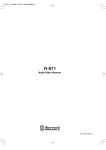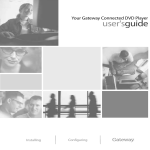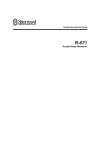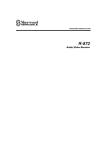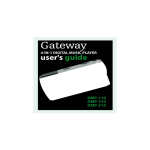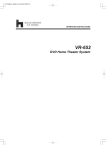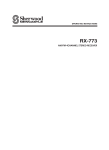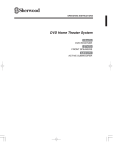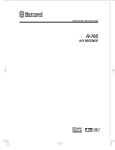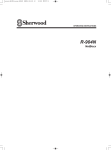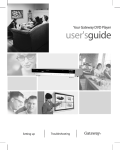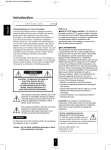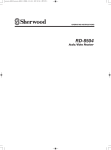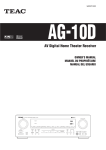Download Gateway kas303 User's Manual
Transcript
Your Gateway KAS-303 Home Theater systemguide Setting up Troubleshooting Contents 1 Checking Out Your Gateway Receiver . . . . . . . . . . . . . . . . . . . . . . . . . . . 1 Features . . . . . . . . . . . . . . . . . . . . . . . . . . . . . . . . . . . . . . . . . . . . . . . . . . . . . . . . . . . 2 Important Safeguards . . . . . . . . . . . . . . . . . . . . . . . . . . . . . . . . . . . . . . . . . . . . . . . . 2 Package contents . . . . . . . . . . . . . . . . . . . . . . . . . . . . . . . . . . . . . . . . . . . . . . . . . . . 3 Front panel . . . . . . . . . . . . . . . . . . . . . . . . . . . . . . . . . . . . . . . . . . . . . . . . . . . . . . . . 4 Display . . . . . . . . . . . . . . . . . . . . . . . . . . . . . . . . . . . . . . . . . . . . . . . . . . . . . . . . . 5 Back panel connections . . . . . . . . . . . . . . . . . . . . . . . . . . . . . . . . . . . . . . . . . . . . . . 6 Universal remote control . . . . . . . . . . . . . . . . . . . . . . . . . . . . . . . . . . . . . . . . . . . . . . 7 Inserting batteries . . . . . . . . . . . . . . . . . . . . . . . . . . . . . . . . . . . . . . . . . . . . . . . 11 2 Connecting Components and Speakers . . . . . . . . . . . . . . . . . . . . . . . . . 13 Understanding video connections . . . . . . . . . . . . . . . . . . . . . . . . . . . . . . . . . . . . . . Understanding audio connections . . . . . . . . . . . . . . . . . . . . . . . . . . . . . . . . . . . . . . Connecting the AM loop antenna . . . . . . . . . . . . . . . . . . . . . . . . . . . . . . . . . . . . . . Connecting the FM antenna . . . . . . . . . . . . . . . . . . . . . . . . . . . . . . . . . . . . . . . . . . Connecting a DVD player . . . . . . . . . . . . . . . . . . . . . . . . . . . . . . . . . . . . . . . . . . . . Connecting a 6 or 7 channel component . . . . . . . . . . . . . . . . . . . . . . . . . . . . . . . . Connecting a VCR . . . . . . . . . . . . . . . . . . . . . . . . . . . . . . . . . . . . . . . . . . . . . . . . . . Connecting a tape component . . . . . . . . . . . . . . . . . . . . . . . . . . . . . . . . . . . . . . . . Connecting an AUX component . . . . . . . . . . . . . . . . . . . . . . . . . . . . . . . . . . . . . . . Connecting a television . . . . . . . . . . . . . . . . . . . . . . . . . . . . . . . . . . . . . . . . . . . . . . Connecting speakers . . . . . . . . . . . . . . . . . . . . . . . . . . . . . . . . . . . . . . . . . . . . . . . . Speaker placement . . . . . . . . . . . . . . . . . . . . . . . . . . . . . . . . . . . . . . . . . . . . . . Making the connections . . . . . . . . . . . . . . . . . . . . . . . . . . . . . . . . . . . . . . . . . . Plugging in your components . . . . . . . . . . . . . . . . . . . . . . . . . . . . . . . . . . . . . . . . . 14 15 16 17 18 19 20 22 23 24 25 25 26 35 3 Using the Receiver . . . . . . . . . . . . . . . . . . . . . . . . . . . . . . . . . . . . . . . . . . . . . . 37 Turning the receiver on and off . . . . . . . . . . . . . . . . . . . . . . . . . . . . . . . . . . . . . . . . Setting up your speakers . . . . . . . . . . . . . . . . . . . . . . . . . . . . . . . . . . . . . . . . . . . . Adjusting the speaker settings . . . . . . . . . . . . . . . . . . . . . . . . . . . . . . . . . . . . . Using the universal remote control . . . . . . . . . . . . . . . . . . . . . . . . . . . . . . . . . . . . . Operating components with the universal remote control . . . . . . . . . . . . . . . . Programming the remote control . . . . . . . . . . . . . . . . . . . . . . . . . . . . . . . . . . . Switching between connected components . . . . . . . . . . . . . . . . . . . . . . . . . . . . . . Surround sound . . . . . . . . . . . . . . . . . . . . . . . . . . . . . . . . . . . . . . . . . . . . . . . . . . . . Surround modes . . . . . . . . . . . . . . . . . . . . . . . . . . . . . . . . . . . . . . . . . . . . . . . . Selecting the surround mode . . . . . . . . . . . . . . . . . . . . . . . . . . . . . . . . . . . . . . Adjusting the channel levels . . . . . . . . . . . . . . . . . . . . . . . . . . . . . . . . . . . . . . . Storing channel levels in memory . . . . . . . . . . . . . . . . . . . . . . . . . . . . . . . . . . 38 39 39 42 42 43 46 47 47 50 52 53 i Adjusting the LFE level . . . . . . . . . . . . . . . . . . . . . . . . . . . . . . . . . . . . . . . . . . .54 Adjusting the tone . . . . . . . . . . . . . . . . . . . . . . . . . . . . . . . . . . . . . . . . . . . . . . .55 Compressing the dynamic range . . . . . . . . . . . . . . . . . . . . . . . . . . . . . . . . . . . .55 Adjusting Dolby Pro Logic II Music parameters . . . . . . . . . . . . . . . . . . . . . . . .56 Listening to the radio . . . . . . . . . . . . . . . . . . . . . . . . . . . . . . . . . . . . . . . . . . . . . . . .57 Selecting the tuner . . . . . . . . . . . . . . . . . . . . . . . . . . . . . . . . . . . . . . . . . . . . . . .57 Manual tuning . . . . . . . . . . . . . . . . . . . . . . . . . . . . . . . . . . . . . . . . . . . . . . . . . . .57 Auto tuning . . . . . . . . . . . . . . . . . . . . . . . . . . . . . . . . . . . . . . . . . . . . . . . . . . . . .58 Memorizing radio stations . . . . . . . . . . . . . . . . . . . . . . . . . . . . . . . . . . . . . . . . .58 Tuning to preset stations . . . . . . . . . . . . . . . . . . . . . . . . . . . . . . . . . . . . . . . . . .59 Analog Audio/Video recording . . . . . . . . . . . . . . . . . . . . . . . . . . . . . . . . . . . . . . . . .59 Digital Audio recording with an MD recorder . . . . . . . . . . . . . . . . . . . . . . . . . . . . . .61 Using the sleep timer . . . . . . . . . . . . . . . . . . . . . . . . . . . . . . . . . . . . . . . . . . . . . . . .62 Adjusting the display brightness . . . . . . . . . . . . . . . . . . . . . . . . . . . . . . . . . . . . . . . .62 4 Using the OSD. . . . . . . . . . . . . . . . . . . . . . . . . . . . . . . . . . . . . . . . . . . . . . . . . . .63 Displaying the current status . . . . . . . . . . . . . . . . . . . . . . . . . . . . . . . . . . . . . . . . . .64 Using the Menu screen . . . . . . . . . . . . . . . . . . . . . . . . . . . . . . . . . . . . . . . . . . . . . .65 OSD menus and options . . . . . . . . . . . . . . . . . . . . . . . . . . . . . . . . . . . . . . . . . .66 5 Maintaining and Troubleshooting Your Receiver . . . . . . . . . . . . . . . .69 Cleaning and maintenance . . . . . . . . . . . . . . . . . . . . . . . . . . . . . . . . . . . . . . . . . . . .70 Troubleshooting . . . . . . . . . . . . . . . . . . . . . . . . . . . . . . . . . . . . . . . . . . . . . . . . . . . .70 Initializing the receiver . . . . . . . . . . . . . . . . . . . . . . . . . . . . . . . . . . . . . . . . . . . .72 Technical support . . . . . . . . . . . . . . . . . . . . . . . . . . . . . . . . . . . . . . . . . . . . . . . . . . .73 Telephone support . . . . . . . . . . . . . . . . . . . . . . . . . . . . . . . . . . . . . . . . . . . . . . .73 Internet . . . . . . . . . . . . . . . . . . . . . . . . . . . . . . . . . . . . . . . . . . . . . . . . . . . . . . . .73 A Specifications and Setup Codes . . . . . . . . . . . . . . . . . . . . . . . . . . . . . . . . .75 Specifications . . . . . . . . . . . . . . . . . . . . . . . . . . . . . . . . . . . . . . . . . . . . . . . . . . . . . .76 LN-520 receiver specifications . . . . . . . . . . . . . . . . . . . . . . . . . . . . . . . . . . . . . .76 KAS-303 speakers specifications . . . . . . . . . . . . . . . . . . . . . . . . . . . . . . . . . . . .78 SW303 subwoofer specifications . . . . . . . . . . . . . . . . . . . . . . . . . . . . . . . . . . . .79 Setup Codes . . . . . . . . . . . . . . . . . . . . . . . . . . . . . . . . . . . . . . . . . . . . . . . . . . . . . . .80 TV setup codes . . . . . . . . . . . . . . . . . . . . . . . . . . . . . . . . . . . . . . . . . . . . . . . . .80 VCR setup codes . . . . . . . . . . . . . . . . . . . . . . . . . . . . . . . . . . . . . . . . . . . . . . . .85 DVD setup codes . . . . . . . . . . . . . . . . . . . . . . . . . . . . . . . . . . . . . . . . . . . . . . . .91 Cable Set-top Box setup codes . . . . . . . . . . . . . . . . . . . . . . . . . . . . . . . . . . . . .92 Satellite Set-top Box setup codes . . . . . . . . . . . . . . . . . . . . . . . . . . . . . . . . . . .95 Aux-Tape/MiniDisc setup codes . . . . . . . . . . . . . . . . . . . . . . . . . . . . . . . . . . . . .96 Aux-Laserdisc setup codes . . . . . . . . . . . . . . . . . . . . . . . . . . . . . . . . . . . . . . . .96 Aux-Tape setup codes . . . . . . . . . . . . . . . . . . . . . . . . . . . . . . . . . . . . . . . . . . . .96 ii Aux-Amplifier setup codes . . . . . . . . . . . . . . . . . . . . . . . . . . . . . . . . . . . . . . . . Aux-Home Automation setup codes . . . . . . . . . . . . . . . . . . . . . . . . . . . . . . . . . Aux-DBS setup codes . . . . . . . . . . . . . . . . . . . . . . . . . . . . . . . . . . . . . . . . . . . . Aux-Accessory setup codes . . . . . . . . . . . . . . . . . . . . . . . . . . . . . . . . . . . . . . . CD setup codes . . . . . . . . . . . . . . . . . . . . . . . . . . . . . . . . . . . . . . . . . . . . . . . . 97 98 98 99 99 B Safety, Regulatory, and Legal Information . . . . . . . . . . . . . . . . . . . . . 103 Index . . . . . . . . . . . . . . . . . . . . . . . . . . . . . . . . . . . . . . . . . . . . . . . . . . . . . . . . . . . . . . 111 iii iv Checking Out Your Gateway Receiver 1 This chapter provides basic information about your Gateway Receiver. Read this chapter to learn about: ■ Warnings and safeguards ■ Controls and connections ■ Remote control 1 Chapter 1: Checking Out Your Gateway Receiver Features A powerful, 1000-watt, 6.1 home theater system featuring TrueDigital™ amplification for premium, multichannel digital sound. ■ 600-watt audio receiver ■ 400-watt Hsu Research™-engineered sub-woofer ■ 5 satellite and 1 Ventriloquist™ center channel speakers ■ Analog and digital audio inputs and outputs. ■ Composite and S-Video video inputs and outputs. Important Safeguards Warning Risk of electric shock - Do not open To reduce the risk of electric shock, do no remove the cover. There are no user-serviceable parts inside. Removing the cover voids the warranty. Have your receiver repaired by qualified service personnel only. Warnings and precautions 2 ■ Disconnect all cables before moving your receiver. Moving your receiver with its cables attached may damage the cables and cause fire or electric shock danger. ■ Do not expose your receiver to rain or moisture. ■ Keep your receiver away from excessive dust, high temperatures, moisture, or direct sunlight. ■ Use your receiver in a well-ventilated area and do not cover the ventilation openings. ■ Do not modify your receiver or use an unshielded power cord or video output source cable, or you may experience excessive interference. www.gateway.com Package contents ■ Disconnect your receiver and unplug the power cord when not used for a long period of time. ■ For more safety information, see “Important safety information” on page 103. Package contents Along with your receiver, the packaging box contains the following items: ■ Remote control ■ Two AAA batteries ■ RCA audio/video cables ■ AM Loop antenna ■ FM antenna ■ User guide You can purchase these optional accessories for your receiver: ■ S-Video cable ■ AC-3 (Toslink) cable www.gateway.com 3 Chapter 1: Checking Out Your Gateway Receiver Front panel Adjust/ Tuning/Preset Display Standby Input Selector 4 Decoding/ Tuning Mode Digital Input/ AM/FM Mode Power Volume Setup/ Memory Headphone jack Item Description Display See “Display” on page 5. Adjust/ Tuning/Preset When in Setup mode, adjusts submenu items. When the tuner is selected, tunes the radio manually, automatically, or to preset radio stations. Volume Turns the volume up or down. Power Turns the receiver on and off. Standby Lights when the receiver is in Standby mode. Input Selector Switches inputs. Digital Input/ AM/FM Mode Digital Input selector when a digital signal (AUX, VIDEO 1-3) is selected. When the tuner is selected, selects the band. Setup/ Memory Press for more than two seconds to enter Setup mode. While in Setup mode, switches between main menu items. When the tuner is selected, memorizes radio stations. Decoding/ Tune Mode When in Setup mode, switches submenu items. When the tuner is selected, switches between Tuning mode and Preset mode. Headphone jack Connect your headphones to this jack. www.gateway.com Front panel Display Direct indicator Stereo indicator Tuned indicator Main display ST TUNED TIMER R2 DIRECT Memory indicator TAPE 2M PRESET MEM 1 dB kHz MHz DTS ES DIGITAL-EX ft PROLOGIC II CM DSP AUTO DIGITAL SLEEP Auto mode indicator Surround mode indicators Preset/Sleep/Distance indicators Digital input signal indicator Item Description Main display Displays items such as, Input source, frequency, volume level, and operating information. STEREO indicator Displays stereo radio signal status. TUNED indicator Displays tuned radio station status. DIRECT indicator Displays direct mode status. MEMory indicator Displays the selected memory channel. Surround mode indicators Displays the currently selected surround sound mode. AUTO indicator Displays automatic mode status. DIGITAL input signal indicator Displays presence of a digital audio signal. PRESET number, SLEEP time, Speaker distance display Displays presets, sleep timer, and speaker distance information. www.gateway.com 5 Chapter 1: Checking Out Your Gateway Receiver Back panel connections Antenna Video Digital Audio Subwoofer Connector Array Description Antenna Connect AM and FM antennas. Video (and audio) components ■ ■ Speakers Connect the VIDEO 1-3 jacks to components, such as a VCR or DVD player. Connect the Monitor jacks to your primary and secondary displays, such as a television or projector. 6 or 7 channel direct input components Connect the analog audio outputs of a 6 or 7 channel component such as a DVD player or external decoder. When connecting a 6 channel component leave the SURR BACK jack empty. Digital INs and OUT ■ ■ Audio (only) components ■ ■ 6 6 or 7 channel direct Connect the Digital INs to the coaxial and optical Digital OUTs of the components connected to AUX and VIDEO 1-3. Connect the Digital OUT to the Digital IN of a digital recorder such as an MD recorder or CD recorder that has a digital input. Connect the TAPE IN/OUT jacks to an audio only-type component, such as a tape deck. Connect the AUX jacks to an additional component such as a CD player. Subwoofer Connect a powered subwoofer. Speakers Connect speakers with an impedance of 6 ohms or above. www.gateway.com Universal remote control Universal remote control This universal remote control can operate not only this receiver, but also most popular brands of audio and video components such as CD players, cassette decks, TVs, cable boxes, VCRs, DVD players, and satellite receivers. To operate up to 7 components, other than this receiver, enter the setup code for each component. For information, see “Programming the remote control” on page 43. LED STANDBY POWER DEVICE MACRO CHANNEL/LEVEL CHANNEL SELECT/T/V MUTE VOLUME SPEAKER SETUP PL II MUSIC PARAMETER ADJUST AUDIO SELECT SUBTITLE AUTO ZOOM STEREO DSP MODE OSD/SETUP TEST TONE/MENU Navigation/ENTER DIMMER/RETURN SLEEP/DISPLAY REVERSE PLAY/PAUSE PLAY P.SCAN RECORD TUNE/SEARCH PRESET/SKIP 7 CH DIRECT Numeric keypad (0-9, 10+)/ Direct INPUT selector www.gateway.com 7 Chapter 1: Checking Out Your Gateway Receiver Button POWER Description Power On. Turns the receiver off or puts the receiver in Standby mode. For more information, see “Turning the receiver on and off” on page 38. LED. Provides visual feedback when performing functions or programming operations. STANDBY Standby. Turns the receiver on or puts the receiver in Standby mode. For more information, see “Turning the receiver on and off” on page 38. Device. Press to put the remote into a specific device mode for operating connected components. For more information, see “Operating components with the universal remote control” on page 42. CH/LEVEL CH/LEVEL CH SEL T/V Channel level. Adjusts a program (television) channel or the test tone channel levels up or down. For more information, see “Adjusting the channel levels” on page 52. Channel select. Selects a specific channel to adjust individual test tone channel levels up or down. For more information, see “Adjusting the channel levels” on page 52. T/V. Changes inputs for connected components such as a TV or VCR. MUTE Mute. Mutes the sound. Volume. Adjusts the overall volume. VOLUME VOLUME ZOOM STEREO DSP T. TONE MENU Zoom. Enlarges a part of the DVD screen. Stereo. Turns off surround mode and puts the receiver into stereo mode. For more information, see “Selecting the surround mode” on page 50. DSP Mode. Cycles through the available surround modes. For more information, see “Selecting the surround mode” on page 50. Test tone. Enters the test tone mode. For more information, see “Adjusting the channel levels” on page 52. Menu. Opens the menu for connected components such as a DVD player. , , , . Navigates the on-screen display (OSD) menus. For more information, see “Using the OSD” on page 63. 8 www.gateway.com Universal remote control Button ENTER DIMMER RETURN Description Enter. Confirms a selection in a menu. For more information, see “Using the OSD” on page 63. Dimmer. Adjusts the display brightness. For more information, see “Adjusting the display brightness” on page 62. Return. Returns from an OSD settings screen to the Setup Menu. For more information, see “Using the OSD” on page 63. Play ( P.SCAN P.Scan. Scans the preset radio stations pausing at each one for 5 seconds. For more information, see “Listening to the radio” on page 57. Stop ( - PRESET + ). Plays the DVD, CD, or MP3. ). Stops playing the disc. Preset/Skip back ( ). Changes the radio station to the next memorized station or performs backward skip functions such as skipping back one CD track or DVD chapter. For more information, see “Listening to the radio” on page 57. Preset/Skip ahead ( ). Changes the radio station to the previous memorized station or performs forward skip functions such as skipping ahead one CD track or DVD chapter. For more information, see “Listening to the radio” on page 57. 7CH DIR. 7 Channel Direct. Selects audio signal from a connected 6 or 7 channel direct input component. For more information, see “Switching between connected components” on page 46. Numeric keypad (0-9, 10+). Enters numbers when selecting or programming. Direct INPUT selector. Selects corresponding connected component as source for audio/video input. For more information, see “Switching between connected components” on page 46. - TUNE + Tune/Search back ( ). Tunes in a radio station or performs backward search functions, such as playing a CD backward quickly or playing a DVD backward in slow motion. For more information, see “Listening to the radio” on page 57. Tune/Search ahead( ). Tunes in a radio station or performs forward search functions, such as playing a CD forward quickly or playing a DVD forward in slow motion. For more information, see “Listening to the radio” on page 57. Record. Starts recording on components, such as a VCR. Reverse play. Reverses play for connected components, such as AUX. Pause ( ). Pauses play. www.gateway.com 9 Chapter 1: Checking Out Your Gateway Receiver Button SLEEP DISPLAY Description Sleep. Sets the receiver to automatically turn off after a set period of time. Shows the on-screen display. For more information, see “Using the sleep timer” on page 62. Display. Turns on the display for connected components, such as a DVD player. OSD OSD. Opens the on-screen display (OSD) menus. For more information, see “Using the OSD” on page 63. SETUP Setup. Opens the setup menu for connected components, such as a DVD player. AUTO Auto. Automactially selects surround mode based on the type of digital input signal detected. For more information, see “Surround sound” on page 47. SUBTITLE Subtitle. Opens the Subtitle menu. AUDIO SEL Audio select. Changes audio track selection for connected components, such as a DVD player. PLII PARA PL II Music Parameter. Adjusts Dolby Pro Logic II music parameters. For more information, see “Adjusting Dolby Pro Logic II Music parameters” on page 56. SPK SET -ADJUST- AUTO 10 Speaker setup. Adjusts speaker settings. For more information, see “Setting up your speakers” on page 39. Adjust. Use to adjust above two settings. Macro. Program macros to send many button presses with the touch of just one button. For more information, see “Programming the remote control” on page 43. www.gateway.com Universal remote control Inserting batteries To install the batteries: ■ Insert two AAA batteries into the remote control. Make sure that you match the + and – on the batteries with the + and – symbols inside the battery compartment. Warning Do not use rechargeable Ni-Cd batteries in this remote control. www.gateway.com 11 Chapter 1: Checking Out Your Gateway Receiver 12 www.gateway.com Connecting Components and Speakers 2 Read this chapter to learn how to connect your receiver to audio/video (A/V) components and speakers. Important Do not plug the power cord into a wall outlet or turn the receiver on until all connections have been made. 13 Chapter 2: Connecting Components and Speakers Understanding video connections Your receiver has two types of standard video connections. You should use the best connection available to get the best display. For example, if your VCR supports an S-video connection, connect the VCR to your receiver using S-video instead of composite video. Connection Quality Cable and Connector Description Good Composite. The video signal is carried through a single “pin.” This connection method is the one that is most commonly found on devices. Better S-Video. The video signal is split into two signals, black-and-white and color. Text displayed on-screen through this connection will be noticeably sharper then composite. 14 www.gateway.com Understanding audio connections Understanding audio connections Your receiver has three types of standard audio connections. You should use the best connection available to get the best sound. For example, if your DVD player supports a digital audio connection, connect the DVD player to your receiver using digital audio instead of analog stereo audio. Connection Quality Cable and Connector Good Description RCA Analog Stereo The audio signal is carried through two cables, one for the right speaker and one for the left. This connection method is the one that is most commonly found on devices. Best Use digital audio for the best sound quality. Your receiver supports the following digital audio connections. Coaxial Digital Coaxial cables are commonly used with digital audio signals. AC-3 (Toslink) Digital -OR- Toslink is a connector format for fiber optic digital audio cables. A fiber optic digital audio cable carries audio data in the form of light impulses instead of electrical signals. The Toslink connector is a square plug. www.gateway.com 15 Chapter 2: Connecting Components and Speakers Connecting the AM loop antenna Place the AM loop antenna as far as possible from the receiver, TV, speaker cables, and the power cord for best reception. The antenna is directional so set it to a direction for the best reception. To connect the AM loop antenna: 16 1 Unfold the AM loop antenna and snap the loop into the base. 2 Connect the antenna leads to the GND and AM clips on your receiver. www.gateway.com Connecting the FM antenna Connecting the FM antenna Change the position of the FM antenna until you get the best reception of your favorite FM stations. To connect the FM antenna: 1 Connect the FM antenna to the FM antenna connector on your receiver. You may improve FM reception by using an outdoor antenna. www.gateway.com 17 Chapter 2: Connecting Components and Speakers Connecting a DVD player or To connect a DVD player to your receiver: 1 Connect the S-Video jack on the back of your DVD player to the S-Video jack on your receiver. 2 Connect the AC-3 toslink digital audio jack on the back of your DVD player to the AC-3 toslink digital audio in jack on your receiver. -ORConnect the coaxial out jack on the back of your DVD player to the coaxial in jack on your receiver. 18 www.gateway.com Connecting a 6 or 7 channel component Connecting a 6 or 7 channel component Use the 7CH DIRECT INPUT connectors on the receiver to connect the corresponding analog outputs of a DVD player or external decoder that has 6 or 7 channel outputs. If you are connecting a 6 channel output component, leave the surround back (SURR BACK) connector on the receiver unused. To connect a 6 or 7 channel component: 1 Connect the analog outputs of your 6 or 7 channel component to the corresponding 7 channel direct input jacks on your receiver. 2 Connect the S-video jack of your 6 or 7 channel component to the S-video jack on your receiver. www.gateway.com 19 Chapter 2: Connecting Components and Speakers Connecting a VCR This receiver supports S-Video and composite video jacks. To connect a VCR using S-Video: • 20 1 Connect the red (R) and white (L) audio out jacks on the back of your VCR to the R and L audio in jacks on your receiver. 2 Connect the red (R) and white (L) audio in jacks on the back of your VCR to the R and L audio out jacks on your receiver. 3 Connect the S-video out jack on the back of your VCR to the S-video in jack on your receiver. 4 Connect the S-video in jack on the back of your VCR to the S-video out jack on your receiver. www.gateway.com Connecting a VCR To connect a VCR using composite video: • 1 Connect the red (R) and white (L) audio out jacks on the back of your VCR to the R and L audio in jacks on your receiver. 2 Connect the red (R) and white (L) audio in jacks on the back of your VCR to the R and L audio out jacks on your receiver. 3 Connect the composite video out jack on the back of your VCR to the composite video in jack on your receiver. 4 Connect the composite video in jack on the back of your VCR to the composite video out jack on your receiver. www.gateway.com 21 Chapter 2: Connecting Components and Speakers Connecting a tape component To connect a tape component: 22 1 Connect the red (R) and white (L) audio out jacks on the back of your tape component to the R and L audio in jacks on your receiver. 2 Connect the red (R) and white (L) audio in jacks on the back of your tape component to the R and L audio out jacks on your receiver. www.gateway.com Connecting an AUX component Connecting an AUX component The AUX jacks may be connected to an additional audio component such as a CD player, tape deck, or game console. To connect an AUX component: 1 Connect the red (R) and white (L) audio out jacks on the back of your AUX component to the R and L audio in jacks on your receiver. www.gateway.com 23 Chapter 2: Connecting Components and Speakers Connecting a television This receiver supports S-Video and composite video jacks. As you are making your television (monitor) connections and using your receiver, keep in mind that a signal input into the composite VIDEO IN jack is output to the composite VIDEO OUT jacks and a signal input into the S-VIDEO IN jack is output to the S-VIDEO OUT jacks and the composite MONITOR 1 and MONITOR 2 VIDEO OUT jacks. For this reason, we recommend connecting your receiver to your TV using both S-Video and composite video. (S-Video cable not supplied) To connect your receiver to a television: 24 1 Connect the Monitor S-Video out jack on the back of your receiver to the S-Video in jack on your television. 2 Connect the Monitor 1 or Monitor 2 composite video out jack on the back of your receiver to the composite video in jack on your television. www.gateway.com Connecting speakers Connecting speakers Speaker placement Ideal speaker placement varies depending on the size of your room, wall coverings, and other environment variables. The following information depicts typical placement recommendations. Front left and right speakers and center speaker ■ Place the front speakers so they are no closer to the listening area than the center speaker. ■ Place the center speaker between the front left and right speakers and no further from the listening area than the front speakers. Generally, center speaker placement is made either directly above or directly below the TV. ■ Place each speaker so that sound is aimed at your ears while you are seated in your main listening area. www.gateway.com 25 Chapter 2: Connecting Components and Speakers Surround left and right speakers ■ Place the surround speakers approximately 40 inches (1 meter) above the ear level of a seated listener on the direct left and right or slightly behind the listener. Surround back speaker ■ Place the surround back speaker at the rear center of your listening area facing toward the listening area at a slightly higher position (0 to 10 inches) than the surround speakers. ■ We recommend installing the surround back speaker at a slightly downward facing angle. This helps prevent the surround back channel signals from reflecting off the TV or screen at the front center. Subwoofer ■ The powerful deep bass sounds produced by the subwoofer are non-directional, meaning you cannot tell where the sound is coming from. Place the subwoofer anywhere in your room. The closer to a wall or corner that you place your subwoofer the bassier the sound becomes. Making the connections Connect speakers firmly and correctly according to their channel (left and right) and their polarity (+ and –). If the connections are faulty, the speakers will not reproduce sound. If the polarity of the connections are incorrect, the sound will be unnatural and lack bass. Warning Use speakers with an impedance of 6 ohms or above. Do not let the bare speaker wires touch each other or any metal part of this receiver. This could damage the receiver and/or the speakers. 26 www.gateway.com Connecting speakers To connect speakers to your receiver: 1 Connect the striped-edge speaker cable to the red (positive) speaker cable connector. Connect the non-striped edge speaker cable to the black (negative) speaker cable connector. Important Make sure that you clamp down on the bare speaker wire and not on the insulation. www.gateway.com 27 Chapter 2: Connecting Components and Speakers 2 28 Connect the right and left surround speakers and the back surround speaker to the receiver. Match the positive and negative cables from Step 1 to the positive and negative connectors on the receiver. www.gateway.com Connecting speakers 3 Connect the center speaker to the receiver, making sure to match the positive and negative connectors. www.gateway.com 29 Chapter 2: Connecting Components and Speakers 4 30 Connect the left and right front speakers to the center speaker, making sure to match the positive and negative connectors. www.gateway.com Connecting speakers 5 Turn the center speaker’s Ventriloquist Function to ON. www.gateway.com 31 Chapter 2: Connecting Components and Speakers 6 32 Connect the subwoofer to the receiver. www.gateway.com Connecting speakers 7 Plug in the subwoofer. www.gateway.com 33 Chapter 2: Connecting Components and Speakers 8 Switch the subwoofer to Digital Receiver, turn the Volume to ~5, then flip the POWER switch to ON. Certain settings need to be made to your receiver to match your KAS-303 speakers. See “Setting up your speakers” on page 39 for more information on setting up and configuring your speakers. 34 www.gateway.com Plugging in your components Plugging in your components After you have made all the connections, plug in your receiver and your connected components. www.gateway.com 35 Chapter 2: Connecting Components and Speakers 36 www.gateway.com Using the Receiver 3 Read this chapter to learn how to: ■ Turn the receiver on and off ■ Set up the speakers ■ Use the universal remote control ■ Listen to a program source ■ Understand surround sound ■ Listen to the radio ■ Record analog audio and video ■ Record digital audio ■ Use the sleep timer ■ Adjust the display brightness 37 Chapter 3: Using the Receiver Turning the receiver on and off To turn the receiver on: 1 Press the power button on the receiver. The receiver enters Standby mode. Each subsequent press of the power button on the receiver switches the receiver between Standby mode and off. 2 Press the power button on the remote control. The receiver turns on. Each subsequent press of the power button on the remote control switches the receiver between Standby mode and on. POWER To turn the receiver off: ■ 38 Press the power button on the receiver. The receiver turns off. www.gateway.com Setting up your speakers Setting up your speakers Adjusting the speaker settings After you have installed your receiver and connected all the components, you should adjust the speaker settings for the optimum sound acoustics for your environment and speaker layout. Setting the type of speakers The composition and frequency response of the signals from the surround channels adjust automatically according to the combination of speaker types in use. Select Large or Small not according to the actual size of the speaker but according to the speaker’s capacity for playing low frequency signals. Crossover Frequency is the frequency (Hz) below which the bass sound of each main speakers is instead sent to the subwoofer or, when not using a subwoofer, speakers set to Large. Large — Select this when connecting speakers that can fully reproduce sounds below the Crossover Frequency of your speakers. Small — Select this when connecting speakers that cannot fully reproduce sound below the Crossover Frequency. When this setting is selected, sound below the Crossover Frequency is assigned to the subwoofer or, when not using a subwoofer, speakers set to Large. None — Select this when no surround speakers are connected. When this setting is selected, the surround sound signals are sent to the front speakers. www.gateway.com 39 Chapter 3: Using the Receiver Yes / None — Select Yes if a subwoofer is connected. Select None if a subwoofer is not connected. 40 ■ See the specifications of the speakers that you are connecting. For example, if the frequency range of your speakers is 80 Hz ~ 12 KHz, then the Crossover Frequency is 80 Hz. ■ If you do not know the specifications for your speakers, try comparing the sound at both settings (set the volume to a low level so you do not damage the speakers) to determine the correct setting. ■ Depending on how you set your speakers, not all options may be available to you. For example, if you set your Front L/R speakers to Large, you will have Large, Small, and None as options for your Center speaker. But if you set your Front L/R speakers to Small, the only options available for your Center speaker will be Small and None. www.gateway.com Setting up your speakers Speaker distance settings When using 5.1 channel surround playback with Dolby Digital or DTS sources, the center and surround speakers should be the same distance from the main listening position as the front speakers. By specifying the distance between the listening position and each speaker, the center and surround speaker’s delay times automatically adjust to create the ideal listening environment. To adjust the speaker settings: SPK SET 1 Press the Speaker Setup button on the remote control to cycle between the available Speaker Setting Modes. 2 When the Speaker Setting Mode you want to adjust is selected, press the -ADJUST- Adjust Up or Adjust Down change the speaker setting. Displayed symbol ■ buttons on the remote control to Corresponding setting F Front C Center S Surround L Large S Small N None When adjusting the Crossover Frequency setting for your subwoofer, the available options are 80 Hz, 120 Hz, 160 Hz, and 200 Hz. Your KAS-303 Home Theater satellite speakers have a range of 150 Hz ~ 18.5 KHz, so set the subwoofer Crossover Frequency to 160 Hz. You can also adjust speaker settings using your remote control and the OSD. For more information, see “OSD menus and options” on page 66. You can also adjust speaker settings using the SETUP button on the receiver www.gateway.com 41 Chapter 3: Using the Receiver Using the universal remote control Operating components with the universal remote control To operate components with the universal remote control: 42 1 Enter the Setup code for each component, other than this receiver, that you want to control. For more information, see “Programming the remote control” on page 43. 2 3 Turn on the component you want to operate. Press the DEVICE button on the remote control that corresponds to the component you want to operate. www.gateway.com Using the universal remote control 4 Aim the remote control at the remote sensor of the component that you want to operate and press the button that corresponds to the function you want to perform. 60o 7m Programming the remote control This remote control can control up to 8 different components. Before operating audio and video components, other than this receiver, use this remote control to enter the setup code for each component. By factory default, 000 is stored in the memory for the CD, DVD, and AUX device buttons. You do not need to enter a code unless the default code of 000 does not work. www.gateway.com 43 Chapter 3: Using the Receiver Entering a setup code To enter a setup code: 1 2 Turn on the component you want to control. 3 While pressing and holding down the ENTER button on the remote control, press the DEVICE button on the remote control for the corresponding component for more than 1 second. The LED flickers once. Locate the setup code for your connected component. See “Setup Codes” on page 80. The AUDIO DEVICE button is reserved for the receiver and cannot be programmed for other components. 4 While aiming the remote control at the remote sensor on your connected component, enter the 3-digit code that you located in Step 2. If you entered the code correctly, the LED flickers twice. Test the code by pressing the POWER (or STANDBY) button on the remote control. If your component does not turn off, repeat the procedure using each code listed for your component’s manufacturer until you find a code that works. If the LED did not flicker twice, repeat the above procedure and try entering the same code again. Manufacturers may use different setup codes for the same product category. Check to see if the code you have entered operates as many controls as possible. If only a few functions operate, check to see if another code operates more buttons. Programming a macro function Using the macro function, you can program up to 10 remote control button presses into a single button. The universal remote control has 3 macro buttons, M1, M2, and M3. 44 www.gateway.com Using the universal remote control To program a macro: 1 Press and hold down both the ENTER button on the remote control and the macro button you want to program (M1, M2, or M3). The LED flickers once. 2 First press the DEVICE button for the device that you want to control with this macro, then press the operation buttons you want to program in the order that you want them to execute. 3 Press the ENTER button on the remote control. If the macro was programmed successfully, the LED flickers twice. Remove a macro by following the above procedure except skip Step 2. Change a macro by programming a new macro into the macro button. The new macro automatically overwrites the old macro. Using a macro function To use a macro: ■ Aim the remote control at the remote control sensor of the component that you want to operate, then press the macro button for the macro you want to run. The macro function of this remote control may not work with all components. For example, the codes programmed into a MACRO button transmit at 0.5 second intervals. If the component cannot complete an operation within 0.5 seconds, it may miss the next code. In this example, you would not be able to use that particular macro with the component. www.gateway.com 45 Chapter 3: Using the Receiver Switching between connected components To switch between connected components: 1 Press the Input Selector button on the receiver or press one of the Direct Input Selector buttons on the remote control. ■ 2 If you selected Aux, Video 1, Video 2, or Video 3, press the Digital Input button on the receiver to select the corresponding digital or analog input. ■ 3 4 5 46 The available input source changes are: Tuner, Tape, Aux, Video 1, Video 2, Video 3, and 7-Direct. The available digital or analog inputs are: A(nalog), o(ptical) 1, o(ptical) 2, and c(oaxial) 1 Press the Decoding button on the receiver or the Auto button on the remote control to select the decoding mode you want. ■ The available decoding modes are: In-Auto, In-DTS, and In-PCM. ■ You cannot select a decoding mode unless you have also selected a digital input source. ■ Noise may be generated at the beginning of playback and while searching when you are in In-Auto decoding mode during DTS playback. If this happens, switch to In-DTS mode. Use the component you selected for playback. Press the up and down Volume buttons on the receiver or on the remote control to adjust the volume. www.gateway.com Surround sound 6 If you want to mute the sound, press the MUTE button on the remote control. 7 If you want to listen with headphones, connect headphones to the Phones jack on the receiver. Sound to the speakers is automatically turned off and any multi-channel sound is automatically downmixed to a 2-channel (2-CH DOWNMIX) downmix mode. You can also select the digital signal input using your remote control and the OSD. For more information, see “Using the OSD” on page 63. Surround sound This receiver incorporates a sophisticated Digital Signal Processor that lets you create optimum sound quality and sound atmosphere in your personal Home Theater. Surround modes Your receiver supports multichannel surround modes and 2-channel surround modes. Multichannel surround modes Mode Description DTS™ Digital Surround DTS Digital Surround (DTS) is a multichannel digital signal format which handles higher data rates than Dolby Digital. DTS - ES Extended Surround™ This is a new multichannel digital signal format which greatly improves the 360-degree surround impression and space expression. In addition to the 5.1 channels, DTS-ES Extended Surround also offers the surround back (sometimes also referred to as surround center) channel for surround playback with a total of 6.1 channels. DTS-ES Extended Surround includes the DTS-ES™ Discrete 6.1 and DTS-ES™ Matrix 6.1 signal formats. DTS Neo: 6™ surround This mode applies conventional two-channel signals such as digital PCM or analog stereo signals to the high precision digital matrix decoder used for DTS-ES Matrix 6.1 to achieve 6.1-channel surround playback. DTS Neo : 6 includes DTS Neo: 6 Cinema and DTS Neo: 6 Music signal formats. www.gateway.com 47 Chapter 3: Using the Receiver Mode Description Dolby Digital™ Dolby Digital discs support recordings of up to 5.1 channels of digital signals, which reproduce much better sound quality, spatial expansion, and dynamic range characteristics than the previous Dolby Surround effects. Dolby Digital EX™ This mode uses a matrix decoder to create the back (sometimes referred to as surround center) signal from the surround left and right signals in a Dolby Digital 5.1 channel source and provides 6.1 channel surround playback. For the best results, this mode should be selected during playback of sources recorded in Dolby Digital Surround EX. When Dolby Digital EX sources are decoded with a Dolby Digital EX decoder, the format is automatically detected and Dolby Digital EX mode is selected. However, some Dolby Digital EX sources may be detected as Dolby Digital sources. In this case, the Dolby Digital EX mode should be selected manually. Dolby Pro Logic™ Dolby Pro Logic is a specially encoded two-channel surround format which consists of four channels (front left, center, front right, and surround). The surround channel is monaural and is played through both surround speakers. Dolby Pro Logic II™ surround This mode applies conventional two-channel signals such as digital PCM or analog stereo signals as well as Dolby Surround signals to surround processing. Dolby Pro Logic II surround includes Dolby Pro Logic II Cinema, Dolby Pro Logic II Music, and Dolby Virtual signal formats. MPEG™ Multichannel Though the number of audio channels is 5.1 (which is the same as Dolby Digital), MPEG Multichannel discs are much better at matching individual sounds to the correct position in the sound stage. MPEG Multichannel works well when using the 7 CH DIRECT INPUTs to playback the sound from an additional multichannel decoder. For details, see to the user’s guide for your connected 7-channel component. 48 www.gateway.com Surround sound 2-channel surround modes The following modes apply conventional 2-channel signals such as digital PCM or analog stereo signals to high performance Digital Signal Processor to recreate sound fields artificially. Select from one of the following 2-channel surround modes: Mode Description Theater This mode provides the effect of being in a theater -in-the round while watching a play. Movie This mode provides the effect of being in a movie theater while watching a movie. Hall 1/2 This mode provides the ambience of a chamber hall for chamber music or an instrumental solo (Hall 1) or a concert hall for orchestral music or an opera (Hall 2). Stadium This mode provides the expansive sound field to achieve the true stadium effect of watching sporting events, such as football. Church This mode provides the ambience of a church for baroque, string orchestral, or choral group music. Club 1/2 This mode creates the sound field of a jazz club with a low ceiling and hard walls (Club 1) or a live club with a relatively spacious floor (Club 2). Arena 1/2 This mode provides the feeling of a live concert in a medium-sized (Arena 1) or large (Arena 2) arena. Game Use this mode for video game sources. Matrix This mode reproduces delayed signals from the surround channels emphasizing the sense of expansion for music sources. www.gateway.com 49 Chapter 3: Using the Receiver For your reference, the sound from each channel can be reproduced according to the surround modes as follows: Modes Channels Front L/R Center Surround L/R Surround Back Subwoofer DTS × × × DTS ES DISCRETE/MATRIX × × × × × DTS NEO CINEMA/MUSIC × × × × × DOLBY DIGITAL × × × DOLBY DIGITAL EX × × × DOLBY PRO LOGIC × × × × DOLBY PRO LOGIC II CINEMA/MUSIC × × × × DOLBY VIRTUAL × MPEG × × × × MATRIX × × × × Other Surround × × × × STEREO × 7 CH DIRECT × × × × × × × × × × × Selecting the surround mode To select the surround mode: ■ 50 Press the left and right DSP mode buttons on the remote control to cycle through the surround modes. www.gateway.com Surround sound The signal format of your selected input source determines the available surround modes. Signal format of input source Selected decoding mode Selectable surround mode * Dolby Digital 5.1, Dolby Digital EX 6.1 channel sources IN-AUTO mode (DOLBY DIGITAL EX), DOLBY DIGITAL, DOLBY VIRTUAL Dolby Digital 2-channel IN-AUTO mode (DOLBY DIGITAL EX), PL II CINEMA, PL II MUSIC, PRO LOGIC, DOLBY VIRTUAL PCM (2 channel) sources IN-AUTO, IN-PCM mode PL II CINEMA, PL II MUSIC, PRO LOGIC, DOLBY VIRTUAL, NEO 6 CINEMA, NEO 6 MUSIC, THEATER, MOVIE, HALL 1/2, STADIUM, CHURCH, CLUB 1/2, ARENA 1/2, GAME, MATRIX DTS sources IN-AUTO, IN-DTS mode corresponding DTS mode MPEG sources IN-AUTO mode corresponding MPEG mode Analog stereo sources * Items in parenthesis are only selectable when the surround back speaker setting is not N. ■ When 96 kHz PCM signals are input, stereo mode is selected automatically and surround mode cannot be selected. ■ When DTS or MPEG signals are input in the IN-AUTO or IN-DTS mode, the corresponding DTS or MPEG modes are selected regardless of DSP MODE button actions. ■ When the selected decoding mode is not matched to the input signal format, the DIGITAL indicator flickers and no sound is heard. Be sure to select the required decoding mode and the available surround mode according to the input signal format. ■ When the 7 CH DIRECT is selected as an input source, the decoding and surround modes cannot be selected. ■ When the selected input signals are not digital signals, the surround mode cannot be selected. ■ When using headphones, the surround mode cannot be selected. www.gateway.com 51 Chapter 3: Using the Receiver To select stereo mode: ■ Press the Stereo button on the remote control to cancel surround mode and switch to stereo mode. If Stereo mode is applied to a multi-channel DTS, Dolby Digital, or MPEG signal, the signal is downmixed to a 2-channel downmix (2-CH DOWNMIX) mode, allowing the multi-channel signal to be reproduced through only two speakers or through headphones. To cancel Stereo mode and switch back to surround mode, use the DSP Mode buttons on your remote control. Adjusting the channel levels You can adjust your channel levels using test tones or manually. Ideally you should use the test tone method first and then make any additional adjustments through the manual process. To adjust channel levels using test tones: 52 1 Press the T. Tone button on the remote control. The test tone plays out of each channel in a 2-second cycle. If a speaker setting is N, the test tone will not play out of that channel. 2 Press the CH/LEVEL up and down buttons on the remote control to adjust the level for each channel. 3 Press the T. Tone button on the remote control to cancel the test tone. www.gateway.com Surround sound To adjust channel levels manually: 1 Press the Ch. SEL button on the remote control. Each time the button is pressed, the corresponding channel is selected and displayed for several seconds. ■ If the receiver is set to Stereo or Dolby Virtual mode or if the speaker setting is set to N, center, surround L/R, surround back, or the subwoofer channel cannot be selected. ■ If the headphones are connected, you can only select the front L/R channel. 2 Press the CH/LEVEL up and down buttons on the remote control to adjust the level of the selected channel. 3 Repeat Step 1 and Step 2 to adjust each channel level. Storing channel levels in memory You can store channel level settings in memory. This lets you change the channel levels, then recall the stored settings. To store channel levels in memory: 1 Press the SETUP button on the receiver for more than 2 seconds to enter Setup mode. 2 While in Setup mode, repeatedly press the SETUP button on the receiver until P CALL appears. 3 While displaying P CALL, press the ADJUST up and down buttons on the receiver to select P MEMORY. 4 Press the DECODING button on the receiver to confirm. www.gateway.com 53 Chapter 3: Using the Receiver To recall channel levels from memory: 1 Press the SETUP button on the receiver for more than 2 seconds to enter Setup mode. 2 While in Setup mode, repeatedly press the SETUP button on the receiver until P CALL displays. 3 While displaying P CALL, press the ADJUST up and down buttons on the receiver to select P CALL. 4 Press the DECODING button on the receiver to confirm. You can also work with channel levels using your remote control and the OSD. For more information, see “OSD menus and options” on page 66. Adjusting the LFE level You can adjust the Low Frequency Effect (LFE) levels in Dolby Digital, DTS, and MPEG program sources. To adjust the LFE level: 1 Press the SETUP button on the receiver for more than 2 seconds to enter Setup mode. 2 While in Setup mode, repeatedly press the SETUP button on the receiver until DD L displays. 3 While displaying DD L, press the DECODING button on the receiver to cycle between the available modes: Dolby Digital LFE (DD L), DTS LFE (DTS L), and MPEG LFE (MP L). 4 While displaying the LFE mode you want, press the ADJUST up and down buttons on the receiver to adjust the level. You can also adjust the LFE level using your remote control and the OSD. For more information, see “OSD menus and options” on page 66. 54 www.gateway.com Surround sound Adjusting the tone You can adjust the tone (bass and treble). To adjust tone: 1 Press the SETUP button on the receiver for more than 2 seconds to enter Setup mode. 2 While in Setup mode, repeatedly press the SETUP button on the receiver until TONE OFF or BASS appears. 3 While displaying BASS, press the DECODING button on the receiver to cycle between the available modes: BASS, TRBL, and TONE ON. 4 While displaying the tone mode you want, press the ADJUST up and down buttons on the receiver to adjust the tone. You can also adjust the tone settings using your remote control and the OSD. For more information, see “OSD menus and options” on page 66. Compressing the dynamic range You can adjust the compression of Dolby Digital program sources to minimize the volume difference between high and low levels. This feature is useful if you are listening to Dolby Digital program sources at low volume levels. This feature can only be used for Dolby Digital program sources. To compress the dynamic range of Dolby Digital program sources: 1 Press the SETUP button on the receiver for more than 2 seconds to enter Setup mode. 2 While in Setup mode, repeatedly press the SETUP button on the receiver until DYNR 0.0 appears. www.gateway.com 55 Chapter 3: Using the Receiver 3 While displaying DYNR 0.0, press the ADJUST up and down buttons on the receiver to cycle between the available modes: DYNR 0.0: Off, DYNR 0.5: Low Compression, and DYNR 1.0: High Compression. 4 While displaying the tone mode you want, press the ADJUST up and down buttons on the receiver to adjust the tone. This function may not be available in some Dolby Digital program sources. You can also adjust the dynamic range compression levels using your remote control and the OSD. For more information, see “OSD menus and options” on page 66. Adjusting Dolby Pro Logic II Music parameters You can adjust the surround parameters of Dolby Pro Logic II Music mode. To adjust Dolby Pro Logic II Music parameters: 1 2 56 Press the PL II PARA. button on the remote control to select from the following parameters: ■ Panorama mode (PANO) – Extends the front stereo image to include the surround speakers to give a wraparound effect with side wall imaging. Range: OFF or ON (default is OFF) ■ Center width control (C-WID) – Adjusts the center image so it is heard from only the center channel speaker, only from the left/right speakers as a phantom image, or from all three front speakers. Range: 0 to 7 (default is 0) ■ Dimension control (DIMEN) – Adjusts the sound field towards the front or towards the rear. Range: -4 to +2 (default is 0) While displaying the parameter you want, press the ADJUST buttons on the remote control to change the values. www.gateway.com Listening to the radio Listening to the radio Selecting the tuner To select the tuner: 1 Press the INPUT SELECTOR button on the receiver or the TUNER button on the remote control to select the tuner. 2 Press the AM/FM MODE button on the receiver to cycle between the following bands: FM STEREO, FM MONO, and AM. When FM stereo broadcasts are poor because of weak broadcast signals, select the FM mono mode to reduce the noise. The FM broadcasts are reduced to monaural sound. Manual tuning To manually tune the tuner: 1 If you are using the buttons on the receiver, repeatedly press the TUNE MODE button on the receiver to select Tuning mode. The PRESET light turns off. - OR If you are using your remote control, go to the next step. 2 Repeatedly press the up and down TUNING/PRESET buttons on the receiver or the – and + TUNE buttons on the remote control until the frequency you want is set. www.gateway.com 57 Chapter 3: Using the Receiver Auto tuning To automatically tune the tuner: 1 If you are using the buttons on the receiver, repeatedly press the TUNE MODE button on the receiver to select Tuning mode. The PRESET light turns off. - OR If you are using your remote control, go to the next step. 2 Press the up and down TUNING/PRESET buttons on the receiver or the – and + TUNE buttons on the remote control for more than 0.5 seconds. The tuner searches until a station of sufficient strength is found. Weak stations are skipped during auto tuning. To tune in a weak station, use manual tuning. Memorizing radio stations You can store up to 30 radio stations in memory. To memorize radio stations: 1 2 Tune in a station using manual or auto tuning. 3 Press the up and down TUNING/PRESET buttons on the receiver or the – and + PRESET buttons on the remote control to select the desired preset number (1~30) you want, then press the MEMORY button on the receiver. Press the MEMORY button on the receiver. The MEM light flickers for 5 seconds. You can erase a stored frequency by storing another frequency in its place. 58 www.gateway.com Analog Audio/Video recording Tuning to preset stations To tune to preset stations: 1 If you are using the buttons on the receiver, repeatedly press the TUNE MODE button on the receiver to select Preset mode. The PRESET light turns on. - OR If you are using your remote control, go to the next step. 2 Press the up and down TUNING/PRESET buttons on the receiver or the – and + PRESET buttons on the remote control to select the desired preset number (1~30). You can scan all of the preset stations in sequence by pressing the P. SCAN button on your remote control. The receiver pauses at each preset station for 5 seconds. When the station you want is tuned, press the button again to stop scanning. Analog Audio/Video recording ■ The analog signals (except front L/R channel) from the 7 CH DIRECT inputs and the digital signals from the coaxial or optical digital inputs cannot be recorded. ■ The volume and tone (bass and treble) settings have no effect on the recording signals. To record with TAPE: 1 Press the INPUT SELECTOR button on the receiver or the direct input selector button on the remote control to select the input for your recording source. You cannot select TAPE. 2 3 Start recording on the connected TAPE component. Start playing on the selected input (recording source). www.gateway.com 59 Chapter 3: Using the Receiver To dub from video components onto VIDEO 1: 1 Press the INPUT SELECTOR button on the receiver or the VIDEO2 or VIDEO3 direct input selector button on the remote control to select VIDEO2 or VIDEO3 as your recording source. 2 3 Start recording on the connected VIDEO 1 component. Start playing on the VIDEO 2 or VIDEO 3 selected input (recording source). To dub separate audio and video source signals onto VIDEO 1: 60 1 Press the INPUT SELECTOR button on the receiver or the AUX direct input selector button on the remote control to select AUX as your audio recording source. Make sure your audio recording source, such as a CD player, is connected to the AUX jacks. 2 Press the OSD button on the remote control and select FUNCTION SELECT, VIDEO SELECT, then select VIDEO 2. 3 4 Start recording on the connected VIDEO 1 component. Start playing on the AUX and the VIDEO 2 inputs (recording source). www.gateway.com Digital Audio recording with an MD recorder Digital Audio recording with an MD recorder . ■ You can only record digitally (without digital to analog conversion) when the OPTICAL DIGITAL OUT jack of this receiver is connected to the OPTICAL DIGITAL IN jack of an MD recorder or CD recorder. ■ Digital recording is available for the digital audio program sources such as CDs, MDs, and some DVDs. ■ In most DVDs, as well as some CDs, digital recording may not be available (depending on the signal format). ■ There are some restrictions on recording digital signals. See the operating instructions of your digital recording equipment to see which restrictions apply to you. To record digital audio with an MD recorder: 1 Press the INPUT SELECTOR button on the receiver or the AUX, VIDEO1, VIDEO2, or VIDEO3 direct input selector button on the remote control to select AUX, VIDEO1, VIDEO2, or VIDEO3 as the input for your recording source. 2 Press the DIGITAL INPUT button on the receiver to select the o(ptical) 1, o(ptical) 2, or c(oaxial) 1 as your digital signal input. 3 4 Start recording on the component connected to OPTICAL DIGITAL OUT. Start playing on the selected digital input (recording source). You can also select the digital signal input using your remote control and the OSD. For more information, see “Using the OSD” on page 63. www.gateway.com 61 Chapter 3: Using the Receiver Using the sleep timer Use the sleep timer to automatically turn the receiver off after a specified period of time. . To use the sleep timer: ■ Press the SLEEP button on the remote control to cycle between the following sleep timer settings: 10, 20, 30, 60, 90, and OFF. The SLEEP light turns on. Adjusting the display brightness You can dim or turn off the receiver’s display. . To adjust the display brightness: ■ Press the DIMMER button on the remote control to cycle between the following brightness settings: ON, dimmer, and OFF. In the OFF display mode, press any button to restore the display to ON mode. 62 www.gateway.com Using the OSD 4 Read this chapter to learn how to adjust your receiver settings from the on-screen display (OSD). 63 Chapter 4: Using the OSD Displaying the current status When the AUTO OSD is set to ON the receiver displays status information. The information displays for several seconds then automatically turns off. One example of displayed status information is shown below. Displayed status information when selecting TEST TONE mode FL 64 :--------------- ----------------: www.gateway.com 0db Using the Menu screen Using the Menu screen Navigate the Menu screen using the cursor control ( , , , and ), OSD OSD ( ), and ENTER ( ENTER ) buttons on your remote control. To adjust settings from the OSD: 1 Press the OSD button on the remote control. The Main Menu opens. MAIN MENU SPEAKER SETUP FUNCTION SELECT SURROUND MODE SH LEVEL SETUP AUTO OSD : ON OSD : QUIT , : MOVE ENTER : SELECT OR CHANGE Press the OSD button on the remote control again to close the Main Menu. 2 Press the cursor up and down buttons on the remote control to select the menu item you want. 3 4 Press Enter on the remote control to confirm your selection. 5 Follow the on-screen instructions to adjust the option. Press the cursor up and down buttons on the remote control to select the option you want. www.gateway.com 65 Chapter 4: Using the OSD OSD menus and options Use these OSD menus and options to adjust various setting for your receiver. Menu Speaker Setup OSD Display Description Configure Speaker settings. Options include: SPEAKER SETUP SUBWOOFER FRONT CENTER SURROUND SURR. BACK : : : : : YES SMALL SMALL SMALL SUBWOOFER : ACTIVE OSD : BACK ENTER :CHANGE , : MOVE 1/2 PAGE UNIT FRONT L FRONT R CENTER SURR. L SURR. R : : : : : : FEET 10ft 10ft 10ft 10ft 10ft U.S. ANGLE : NARROW CROSSOVER FREQ. : 80Hz OSD : BACK ENTER :CHANGE , Page 1/2 SMALL : MOVE 2/2 PAGE Subwoofer – Set to Yes or No. ■ Front – Set size. ■ Center – Set size. ■ Surround – Set size. ■ Surround Back – Set size. ■ Subwoofer – Set type. Page 2/2 ■ ■ ■ ■ ■ ■ ■ ■ ■ Function Select FUNCTION SELECT DIGITAL INPUT VIDEO SELECT TONE CONTROL DYNAMIC RANGE : 0.5 PLII (M) PARAMETER OSD : BACK , : MOVE ENTER : SELECT OR CHANGE Configure Function settings. Options include: ■ ■ ■ ■ ■ 66 www.gateway.com Unit – Set english or metric. Front L – Set distance. Front R – Set distance. Center – Set distance. Surround Left – Set distance. Surround Right – Set distance. V.S. Angle – Set angle. Crossover Frequency – Set subwoofer crossover frequency. Digital Input – Configure digital inputs. Video Select – Configure video dubbing settings. Tone Control – Configure tone (bass/treble) settings. Dynamic Range – Set dynamic range. PLII Parameter – Adjust the Dolby Pro Logic II Music parameter. Using the Menu screen Menu OSD Display Surround Mode Description SURROUND MODE PLII (CINEMA) DOLBY VIRTUAL NEO :6 SFE DOLBY DIGITAL EX STEREO ENTER : , : CHANGE SELECT OR CHANGE Configure the Surround mode settings. The displayed surround modes change depending on the format of the selected input signal. Options can include: ■ ■ ■ ■ ■ ■ Channel Level Setup CH LEVEL SETUP PRESET CALL PRESET TRIM CH LEVEL TRIM LFE LEVEL TRIM OSD : BACK ENTER : SELECT Auto OSD , PLII Dolby NEO SFE Dolby Digital Stereo Configure Channel Level settings such as Preset Trim and Channel Level Trim. See “Adjusting the channel levels” on page 52. : MOVE MAIN MENU SPEAKER SETUP FUNCTION SELECT SURROUND MODE SH LEVEL SETUP AUTO OSD : ON Cycle the Auto OSD setting between On and Off by pressing the Enter button on the remote control. OSD : QUIT , : MOVE ENTER : SELECT OR CHANGE www.gateway.com 67 Chapter 4: Using the OSD 68 www.gateway.com Maintaining and Troubleshooting Your Receiver 5 Read this chapter to learn how to maintain and troubleshoot your receiver. 69 Chapter 5: Maintaining and Troubleshooting Your Receiver Cleaning and maintenance ■ Your receiver is cooled by air circulated through the vents on the bottom of the case. Keep these vents free of dust. With the receiver turned off and unplugged, brush the dust away from the vents with a damp cloth. Be careful not to drip any water into the vents. Do not attempt to clean dust from the inside of your receiver. ■ Do not use abrasive or solvent cleaners because they can damage the finish. ■ Do not allow any excessive water or moisture to come into contact with the surface of the receiver. If water or moisture gets inside your receiver, operating problems and electrical and shock hazards may result. ■ Do not scratch or hit the case with your fingers or any hard objects. Troubleshooting As a general troubleshooting step turn you receiver off, then turn it on again. This section provides some solutions to common problems you may experience with your receiver. If the problem continues, initialize your receiver by following the procedure in “Initializing the receiver” on page 72. No power ■ Connect the power cord securely. ■ Check the outlet using a lamp or another appliance. Power shuts off abruptly during operation. ■ Switch off the power and check the speaker connections. ■ Adjust the speaker settings correctly. ■ Lower the volume. No sound 70 ■ Check the speaker connections. ■ Adjust the master volume. ■ Press the MUTE button to cancel the muting effect. support..gateway.com Troubleshooting ■ Check component connections. ■ Check the selected input source. No sound from the surround speakers ■ Select a surround mode. ■ Adjust master volume and surround level. ■ Select the desired surround speaker setting. ■ Select a stereo or surround source. No sound from the center speaker ■ Select the desired surround speaker setting. ■ Adjust master volume and center level. ■ Make sure center speaker setting is not set to N. No sound from the surround back speaker ■ Under the proper situations, perform the 6.1 surround playback. ■ Adjust master volume and surround back level. ■ Select the desired surround back speaker setting. Stations cannot be received ■ Connect an antenna. ■ Move the antenna and retry tuning. ■ Tune in the desired station frequency. Preset stations cannot be received ■ Memorize the correct station frequency. ■ Memorize the stations again. Poor FM reception ■ Connect an antenna. ■ Change the position of the antenna. support..gateway.com 71 Chapter 5: Maintaining and Troubleshooting Your Receiver Continuous hissing noise during FM reception, especially when a stereo broadcast is received. ■ Change the position of the antenna. ■ Install an outdoor antenna. Continuous or intermittent reception, especially at night. hissing noise during AM ■ Keep the receiver away from noise sources such as, motors, fluorescent lamps, and lightning. ■ Install an outdoor AM antenna. Remote control unit does not operate. ■ Replace the batteries. ■ Remove any obstacles blocking the remote sensor. OSD function is not available ■ Make proper video connections. Initializing the receiver If the display or operation of the receiver is not performing correctly, you can initialize the receiver by performing the following procedure. Initializing the receiver resets any stored settings back to factory defaults. You will have to reprogram any custom stored settings. To initialize the receiver: 72 1 While in Standby mode, press the SETUP and DECODING buttons at the same time. 2 After you see the flickering Standby indicator, release the buttons. support..gateway.com Technical support Technical support Telephone support For customer service and support, call 1-800-846-2301 between 7 am and 10pm Central Time Monday through Friday. Internet For technical support, go to the Gateway Support Web site at support.gateway.com. support..gateway.com 73 Chapter 5: Maintaining and Troubleshooting Your Receiver 74 support..gateway.com Specifications and Setup Codes A Use this appendix as a reference for your receiver’s specifications and setup codes. 75 Specifications LN-520 receiver specifications Amplifier Power output (stereo mode): 6 Total harmonic distortion: 6 Ω, THD 0.3%, 40 Hz~20 kHz | 2×100 W Ω, 50 W, 1 kHz | 0.09% Intermodulation distortion: 60 Hz : 7 kHz= 4 : 1 SMPTE, 6 ., 100 W | 0.1% Input sensitivity: 47 kΩ, Line (AUX) | 200 mV Signal to noise ratio, IHF “A” weighted: Line (TAPE) | 95 dB Frequency response: Line (AUX, TAPE), 20 Hz~44 kHz | ±3 dB Output level: TAPE OUT, 2.2 kΩ | 180 mV Bass/Treble control, 100 Hz/10 kHz | ±10 dB Surround mode, only channel driven: ■ ■ ■ ■ Digital Audio Front power output, 6 Ω, 1 kHz, THD 0.3% | 100 W+100 W Center power output, 6 Ω, 1 kHz, THD 0.3% | 100 W Surround power output, 6 Ω, 1 kHz, THD 0.3% | 100 W+100 W Surround back power output, 6 Ω, 1 kHz, THD 0.3% | 100 W Sampling frequency | 32, 44.1, 48, 96 kHz Digital input level: Coaxial, 75 Ω | 0.5 Vp-p Optical, 660 nm | -15 ~ -21 dBm Video Video format | NTSC Input sensitivity (=Output level), 75Ω ■ ■ ■ FM Tuner Video (Composite (normal)) | 1 Vp-p S-Video (luminance signal) | 1 Vp-p (chrominance signal) | 0.286 Vp-p Tuning frequency range | 87.5~108 MHz Usable sensitivity, THD 3%, S/N 30 dB | 17.2 dBf 50 dB quieting sensitivity, mono/stereo | 20.8/41.2 dBf 76 www.gateway.com Specifications Signal to noise ratio, 1 mV, mono/stereo | 72/65 dB Total harmonic distortion, 1 kHz, mono/stereo | 0.2/0.4% Frequency response, 20 Hz~15 kHz | ±1 dB Stereo separation, 65 dBf, 1 kHz | 45 dB Capture ratio | 4 dB IF rejection ratio | 120 dB AM Tuner Tuning frequency range | 520~1710 kHz Usable sensitivity | 500 µV/m Signal to noise ratio | 40 dB Selectivity | 25 dB General Power supply | 120 V~60 Hz Power consumption | 110 W Dimensions (W×H×D) | 17 1/8 × 2 7/8 × 10 inches (435 × 73.5 × 254 mm) Weight (Net) | 4.2 kg (9.3 Ibs) Note: Design and specifications are subject to change without notice for improvements. www.gateway.com 77 KAS-303 speakers specifications Satellites Video-shielded, 2.5 in (6.4 cm) full range driven Enclosure: Black vinyl laminated MDF Dimensions: 5.75 in (14.6 cm) H × 3.875 in (9.8 cm) W × 3.5 in (8.9 cm) D Center-Channels Video-shielded, two 4 in (10.2 cm) × 6 in (15.2 cm) woofers, one 2.5 in (6.4 cm) mid-high driver Enclosure: Black vinyl laminated MDF Dimensions: 5.25 in (13.3 cm) H × 16.5 in (41.9 cm) W × 8.75 in (22.2 cm) D System Specifications (including subwoofers) System Frequency Response: 23Hz.- 18.5kHz +/- 3dB Characteristic Sensitivity: 90 dB @ 1 watt, 1 meter Nominal Impedance: 8 ohms 78 www.gateway.com Specifications SW303 subwoofer specifications Design Venturi ported system Amplifier Power 150 watts RMS (400 max.) Signal-to-Noise Ratio Greater than 80 dB Damping factor >500 Crossover 40-180 Hz. (user variable), active low-pass, 24 dB/octave Subsonic Filter 18 dB/octave below 20 Hz. Driver Complement One 10 in(25.4 cm) long-throw woofer Frequency Response 23-180 Hz.+/- 3dB variable Output Normalized 1 meter maximum SPL 112 dB average from 27 Hz.-100 Hz. Dimensions 18.5 in (47 cm) H × 17 in (43.2 cm) W × 14 in (35.6 cm) D Shipping Weight 41 lbs. (18.6 kg.) Finish Black laminate www.gateway.com 79 Setup Codes TV setup codes AOC 005 003 Admiral 041 031 Aiko 014 Akai 005 Alaron 026 Ambassador 024 America Action 027 Ampro 043 Anam 027 047 048 049 Audiovox 030 027 014 034 Baysonic 027 Belcor 003 Bell & Howell 019 Bradford 027 Brockwood 003 Broksonic 028 CXC 027 Candle 005 Carnivale 005 Carver 010 Celebrity 050 Cineral 030 014 Citizen 012 005 011 006 Concerto 011 Contec 027 80 001 031 011 www.gateway.com 014 Setup Codes Craig 027 Crosley 010 Crown 027 006 Curtis Mathes 007 010 019 008 030 041 012 005 016 011 001 006 022 032 038 040 Daewoo 030 003 006 014 034 035 Daytron 003 Denon 016 Dumont 002 003 Dwin 044 036 Electroband 050 Emerson 019 028 031 027 029 025 003 026 006 024 034 035 026 023 029 025 Envision 005 Fisher 019 Fujitsu 026 Funai 027 Futuretech 027 GE 007 008 030 041 004 015 038 040 Gibralter 002 005 003 Goldstar 005 025 003 Gradiente 009 011 Grunpy 027 026 Hallmark 025 Harley Davidson 026 Harman/Kardon 010 Havard 027 011 www.gateway.com 81 Hitachi 016 Infinity 010 Inteq 002 JBL 010 JCB 050 JVC 009 KEC 027 KTV 027 005 Kenwood 005 003 LG 011 003 LXI 007 010 019 020 Logik 001 Luxman 011 MGA 017 005 025 003 MTC 012 005 003 011 Magnavox 010 005 026 Magestic 001 Marantz 010 Matsushita 042 Magatron 025 016 Memorex 019 042 031 017 025 002 008 006 015 017 025 003 011 018 046 006 025 005 001 Midland 007 Minutz 004 Mitsubishi 041 Motorola 041 Multitech 027 NAD 020 025 022 NEC 005 003 011 NTC 014 82 www.gateway.com 011 Setup Codes Nikko 005 025 014 Onwa 027 Optimus Optonica 019 042 022 041 021 Orion 028 031 Panasonic 008 042 Penney 007 020 008 012 005 025 004 003 011 006 015 040 Pilco 010 031 005 016 003 Philips 010 Pilot 005 003 006 Pioneer 022 Portland 003 006 014 Prism 008 Proscan 007 Proton 025 032 Pulsar 002 003 Quasar 008 042 021 RCA 007 008 041 003 013 015 037 038 039 040 007 019 021 027 005 025 003 011 006 019 021 027 005 025 003 011 006 Runco 002 005 SSS 027 003 Sampo 005 006 Samsung 012 005 003 011 045 Samsux 006 Radio Shack Realistic 026 033 025 www.gateway.com 83 Sansei 030 Sansui 031 Sanyo 019 Scimitsu 003 Scotch 025 Scott 028 027 025 003 026 Sears 007 010 019 020 025 026 011 006 003 026 Semivox 027 Semp 020 Sharp 041 Sherwood 000 Shogun 003 Signature 001 Sony 050 Soundesign 027 Squareview 023 Starlite 027 Supreme 050 Sylvania 010 Symphonic 023 TMK 025 Tandy 041 Technics 008 Technoi Ace 026 Techwood 008 011 Teknika 010 027 017 012 011 001 006 014 020 012 Telefunken 011 Toshiba 019 84 021 006 025 026 005 011 024 042 www.gateway.com Setup Codes Totevision 006 Vector Research 005 Victor 009 Vidikron 010 Vidtech 025 003 Wards 010 021 005 026 011 001 White Westinghouse 031 034 035 Yamaha 005 003 Zenith 002 031 001 025 004 003 014 VCR setup codes Admiral 027 021 Adventura 000 Aiko 025 Aiwa 005 Akai 026 America Action 025 America High 004 Asha 023 Audiovox 005 Beaumark 023 Bell & Howell 017 Brocksonic 021 Broksonic 020 018 CCE 015 025 Calix 005 000 021 001 www.gateway.com 85 Canon 004 Carver 081 Cineral 025 Citizen 005 Colt 015 Craig 005 012 023 015 Curtis Mathes 013 004 026 028 Cybernex 023 Daewoo 010 Denon 008 Dynatech 000 Electrohome 005 Electrophonic 005 Emerex 002 Emerson 005 020 000 018 001 025 Fisher 012 017 Fuji 004 003 Funai 000 GE 013 027 023 Garrard 000 Go Video 052 GoldStar 005 Gradiente 000 HI-Q 012 Harley Davidson 000 Harman/Kardon 016 86 025 024 025 004 006 006 www.gateway.com 009 021 Setup Codes Harwood 015 Headquarter 011 Hitachi 000 Hughes Net.Sys 008 JVC 014 Jensen 026 KEC 005 KLH 015 Kenwood 014 026 Kodak 004 005 LXI 005 Lloyd’s 000 Logik 015 MEI 004 MGA 023 MGN Technology 023 MTC 023 Magnasonic 025 Magnavox 004 Magnin 023 Marantz 004 Marta 005 Matsushita 004 028 029 Memorex 004 005 000 008 026 026 025 006 009 000 007 016 000 019 027 007 012 023 017 021 011 031 032 009 016 Minolta 008 Mitsubishi 027 014 Motorola 004 027 Multitech 000 015 www.gateway.com 87 NEC 017 014 026 006 Nikko 005 Noblex 023 Olympus 004 Opimus 005 027 017 028 029 031 032 Orion 020 021 001 Panasonic 004 028 022 029 031 Penny 004 005 023 008 006 Pentax 008 Philco 004 021 Philips 004 016 Pilot 005 Pioneer 014 Profitronic 023 Proscan 013 Protec 015 Pulsar 007 Quarter 011 Quartz 011 Quasar 004 028 029 031 RCA 013 004 027 023 008 019 Radio Shack 000 Radix 005 Randex 005 Realistic 004 005 027 012 000 017 011 Runco 007 STS 008 88 www.gateway.com 030 Setup Codes Samsung 023 010 033 Sanky 027 007 Sansui 000 014 021 026 Sanyo 012 023 017 011 Scott 020 010 018 009 Sears 004 005 012 000 024 008 017 011 Semp 010 Sharp 027 Shintom 015 Shogun 023 Singer 015 Sony 004 002 000 003 Syvania 004 016 000 009 Symphonic 000 TMK 023 Tatung 026 Teac 000 026 Technics 004 028 Teknika 004 005 Thomas 000 Toshiba 010 009 Totevision 005 023 Unitech 023 Vector 010 Vector Research 006 Video Concepts 010 000 www.gateway.com 89 Videosonic 023 Wards 013 004 027 012 000 008 015 019 White WestingHouse 021 025 XR-100 004 000 015 Yamaha 006 Zenith 007 000 021 Ameira High 004 (TV use 008) Brocksonic 001 Colt 015 Cutis Mathes 004 (TV use 008) Daewoo 025 Emerson 001 Funai 000 GE 004 (TV use 008) 013 (TV use 012) 027 (TV use 041) 023 Hitachi 004 (TV use 008) 000 HQ 000 Lloyds 000 MGA 023 Megavox 016 (TV use 010) 023 Memorex 005 004 (TV use 008) 028 (TV use 025) Mitsubishi 027 (TV use 041) Orion 001 90 023 003 000 Magnin 016 www.gateway.com Setup Codes Panasonic 004 (TV use 008) 028 (TV use 042) Penney 004 (TV use 008) 023 028 (TV use 042) Quasar 004 (TV use 008) 028 (TV use 042) RCA 013 (TV use 012) 004 (TV use 008) 027 (TV use 041) Sansui 000 Sanyo 023 Sear 000 005 Sharp 027 (TV use 041) Sony 002 (TV use 000) Symphonic 000 Zenith 000 DVD setup codes Harman/Kardon 009 JVC 008 Kenwood 005 Megavox 011 Mitsubishi 016 Onkyo 011 Panasonic 013 Philips 011 006 Pioneer 003 014 Proscan 002 026 www.gateway.com 91 RCA 002 Samsung 017 Sherwood 001 012 000 018 019 020 021 022 023 025 Sony 004 Technics 013 Theta Digital 014 Toshiba 011 Yamaha 013 007 Zenith 011 010 Cable Set-top Box setup codes ABC 002 003 009 007 006 008 Allegro 018 021 Archer 018 026 Bell&Howell 009 Century 018 Citizen 018 Comtronics 014 Contec 011 Easten 001 Emerson 026 Everquest 010 Focus 022 Garrard 018 Gemini 010 General Instrument 033 92 030 021 014 276 006 034 www.gateway.com Setup Codes GoldStar 017 Goodmind 026 Hamlin 012 Hitachi 006 Hytex 007 Jasco Jerrold 040 020 004 010 018 021 002 007 033 006 034 Memolex 000 Movie Time 015 NSC 015 Oak 011 Optimus 031 Panasonic 000 Paragon 000 Philips 018 Pioneer 017 Popular Mechanics 022 Pulsar 000 Quasar 000 RCA 031 Radio Shack 010 Recoton 022 Regal 012 Regency 001 Rembrandt 006 Runco 000 SL Marx 014 016 013 032 009 010 031 025 021 026 028 020 www.gateway.com 93 Smasung 017 014 Scientific Atlanta 003 023 Signal 010 014 Signature 006 Sprucer 031 Starcom 002 010 Stargate 010 014 Starquest 010 TV86 015 Teleview 014 Tocom 007 Toshiba 000 Tusa 010 Unika 018 United Artists 007 Universal 153 Viewstar 015 Zenith 000 Zentek 022 94 030 027 026 008 019 024 www.gateway.com Setup Codes Satellite Set-top Box setup codes AlphaStar 008 Chaparral 001 Echostar 009 Expreevu 009 General Instrument 016 HTS 009 Hitachi 011 Hughes Net.Sys 007 JVC 009 Jerrold 016 015 Megavox 006 005 Memorex 006 Next Level 006 Panasonic 017 Philips 006 005 Primestar 016 015 RCA 003 000 002 Radio Shack 018 Realistic 014 Sony 004 Star Choice 018 Toshiba 010 Uniden 006 005 014 Zenith 013 015 018 012 www.gateway.com 95 Aux-Tape/MiniDisc setup codes Sherwood 000 (for tape deck) 035 (for MD recorder) Aux-Laserdisc setup codes Denon 007 Mitsubishi 007 NAD 007 Pioneer 007 Sony 017 018 Aux-Tape setup codes Aiwa 004 Carver 004 Harman/Kardon 016 004 JVC 022 024 Kenwood 008 Megavox 004 Marantz 004 Onkyo 012 025 Opimus 002 020 Panasonic 038 Pioneer 002 Sansui 004 Sony Technics 021 038 Victor 024 96 034 020 011 014 026 www.gateway.com Setup Codes Wards 002 Yamaha 010 009 Aux-Amplifier setup codes Awia 029 Carver 023 Curtis Mathes 027 Denon 037 Harman/Kardon 040 Linn 023 Megavox 023 Marantz 023 Panasonic 039 Philips 023 040 Pioneer 003 027 Sony 019 033 Technics 039 Wards 003 Yamaha 028 www.gateway.com 97 Aux-Home Automation setup codes GE 043 Lutron 044 One For All 042 Radio Shack 043 Security System 042 Universal X10 042 X10 042 Aux-DBS setup codes Awia 045 Fisher 005 Harman/Kardon 046 JBL 046 JVC 047 Jerrold 031 RCA 006 Scientific Artlanta 032 Sony 045 Starcom 031 98 059 029 www.gateway.com Setup Codes Aux-Accessory setup codes Archer 013 GC Electronics 013 Jebsee 013 Rabbit 036 Radio Shack 013 CD setup codes Awia 010 030 Burmester 019 California Audio Lab 002 Carver 010 DKK 001 Denon 028 Emerson 035 Fisher 012 033 Garrard 019 018 Genexxa 004 035 Harman/Kardon 010 011 Hitachi 004 JVC 007 Kenwood 003 Krell 010 LXI 035 Linn 010 MCS 002 012 020 034 029 016 024 www.gateway.com 025 99 MTC 019 Megavox 010 035 Marantz 002 010 Mission 010 NSM 010 Nikko 033 Onkyo 008 026 Opimus 001 004 012 035 019 009 021 020 Panasonic 002 031 Parasound 019 Philips 010 023 Pioneer 004 035 021 017 Proton 010 QED 010 Quasar 002 RCA 012 035 006 036 Realistic 012 019 013 Rotel 010 019 SAE 010 Sansui 010 Sanyo 012 Scott 035 Sears 035 Sharp 029 013 037 Sherwood 013 027 038 014 022 013 035 039 000 Sony 001 Soundesign 009 Tascam 019 100 029 www.gateway.com 040 041 Setup Codes Teac 019 018 Technics 002 031 Victor 007 Wards 010 006 Yamaha 005 015 Yorx 032 033 013 www.gateway.com 101 102 www.gateway.com Safety, Regulatory, and Legal Information B Important safety information 1 Read Instructions - All the safety and operating instructions should be read before the product is operated. 2 Retain instructions - The safety and operating instructions should be retained for future reference. 3 Heed Warnings - All warnings on the product and in the operating instructions should be adhered to. 4 Follow Instructions - All operating and use instructions should be followed. 5 Cleaning - Unplug this product from the wall outlet before cleaning. Do not use liquid cleaners or aerosol cleaners. Use a damp cloth for cleaning. 6 Attachments - Do not use attachments not recommended by the product manufacturer as they may cause hazards. 103 Safety, Regulatory, and Legal Information 7 Water and Moisture - Do not use this product near water - for example, near a bath tub, wash bowl, kitchen sink, or laundry tub; in a wet basement, or near a swimming pool; and the like. 8 Accessories - Do not place this product on an unstable cart, stand, tripod, bracket, or table. The product may fall, causing serious injury to a child or adult, and serious damage to the product. Use only with a cart, stand, tripod, bracket, or table recommended by the manufacturer, or sold with the product. Any mounting of the product should follow the manufacturer's instructions, and should use a mounting accessory recommended by the manufacturer. 9 A product and cart combination should be moved with care. Quick stops, excessive force, and uneven surfaces may cause the product and cart combination to overturn. 10 Ventilation - Slots and openings in the cabinet are provided for ventilation and to ensure reliable operation of the product and to protect it from overheating, and these openings must not be blocked or covered. The openings should never be blocked by placing the product on a bed, sofa, rug, or other similar surface. This product should not be placed in a built-in installation such as a bookcase or rack unless proper ventilation is provided or the manufacturer's instructions have been adhered to. 11 Power Sources - This product should be operated only from the type of power source indicated on the marking label. If you are not sure of the type of power supply to your home, consult your product dealer or local power company. For products intended to operate from battery power, or other sources, refer to the operating instructions. 12 Grounding or Polarization - This product may be equipped with a polarized alternating-current line plug (a plug having one blade wider than the other). This plug will fit into the power outlet only one way. This is a safety feature. If you are unable to insert the plug fully into the outlet, try reversing the plug. If the plug should still fail to fit, contact your electrician to replace your obsolete outlet. Do not defeat the safety purpose of the polarized plug. Alternate Warnings - This product is equipped with a three-wire grounding-type plug, a plug having a third (grounding) pin. This plug will only fit into a grounding-type power outlet. this is a safety feature. If you are unable to insert the plug into the outlet, contact your electrician to replace your obsolete outlet. Do not defeat the safety purpose of the grounding-type plug. 13 Power-Cord Protection - Power-supply cords should be routed so that they are not likely to be walked on or pinched by items placed upon or against them, paying particular attention to cords at plugs, convenience receptacles, and the point where they exit from the product. 14 Outdoor Antenna Grounding - If an outside antenna or cable system is connected to the product, be sure the antenna or cable system is grounded so as to provide some protection against voltage surges and built-up static charges. Article 810 of the National Electrical Code, ANSI/NFPA 70, provides information with regard to proper grounding of the mast and supporting structure, grounding of the lead-in wire to an antenna discharge unit, size of grounding conductors, location of antenna-discharge unit, connection to grounding electrodes, and requirements for the grounding electrode. See Figure 1. 15 Lightning - For added protection for this product during a lightning storm, or when it is left unattended and unused for long periods of time, unplug it from the wall outlet and disconnect the antenna or cable system. This will prevent damage to the product due to lightning and power-line surges. 16 Power Lines - An outside antenna system should not be located in the vicinity of overhead power lines or other electric light or power circuits, or where it can fall into such power lines or circuits. When installing an outside antenna system, extreme care should be taken to keep from touching such power lines or circuits as contact with them might be fatal. 104 www.gateway.com Important safety information 17 Overloading - Do not overload wall outlets, extension cords, or integral convenience receptacles as this can result in a risk of fire or electric shock. 18 Object and Liquid Entry - Never push objects of any kind into this product through openings as they may touch dangerous voltage points or short-out parts that could result in a fire or electric shock. Never spill liquid of any kind on the product. 19 Servicing - Do not attempt to service this product yourself as opening or removing covers may expose you to dangerous voltage or other hazards. Refer all servicing to qualified service personnel. 20 Damage Requiring Service - Unplug this product form the wall outlet and refer servicing to qualified service personnel under the following conditions: ■ When the power-supply cord or plug is damaged, ■ If liquid has been spilled, or objects have fallen into the product, ■ If the product has been exposed to rain or water, ■ If the product does not operate normally by following the operating instructions. Adjust only those controls that are covered by the operating instructions as an improper adjustment of other controls may result in damage and will often require extensive work by a qualified technician to restore the product to its normal operation. ■ If the product has been dropped or damaged in any way, and ■ When the product exhibits a distinct change in performance - this indicates a need for service. 21 Replacement Parts - When replacement parts are required, be sure the service technician has used replacement parts specified by the manufacturer or have the same characteristics as the original part. Unauthorized substitutions may result in fire, electric shock, or other hazards. 22 Safety Check - Upon completion of any service or repairs to this product, ask the service technician to perform safety checks to determine that the product is in proper operating condition. 23 Wall or Ceiling Mounting - The product should be mounted to a wall or ceiling only as recommended by the manufacturer. 24 Heat - The product should be situated away from heat sources such as radiators, heat registers, stoves, or other products (including amplifiers) that produce heat. Notes: 1 Item 12 is not required except for grounded or polarized product. 2 Item 14 and 16 are not required except for units provided with antenna terminals. 3 Item 14 complies with UL in U.S.A. www.gateway.com 105 Safety, Regulatory, and Legal Information Regulatory compliance statements United States of America Federal Communications Commission (FCC) Unintentional emitter per FCC Part 15 This device has been tested and found to comply with the limits for a Class B digital device, pursuant to Part 15 of the FCC rules. These limits are designed to provide reasonable protection against harmful interference in a residential installation. This equipment generates, uses, and can radiate radio frequency energy and, if not installed and used in accordance with the instructions, may cause harmful interference to radio or television reception. However, there is no guarantee that interference will not occur in a particular installation. If this equipment does cause interference to radio and television reception, which can be determined by turning the equipment off and on, the user is encouraged to try to correct the interference by one or more of the following measures: ■ Reorient or relocate the receiving antenna ■ Increase the separation between the equipment and receiver ■ Connect the equipment to an outlet on a different circuit from that to which the receiver is connected ■ Consult the dealer or an experienced radio/TV technician for help. This device complies with Part 15 of the FCC Rules. Operation of this product is subject to the following two conditions: (1) this device may not cause harmful interference, and (2) this device must accept any interference received, including interference that may cause undesired operation. Caution Changes or modifications not expressly approved by Gateway could void the FCC compliance and negate your authority to operate the product. Canada Industry Canada (IC) Unintentional emitter per ICES-003 This digital apparatus does not exceed the Class B limits for radio noise emissions from digital apparatus as set out in the radio interference regulations of Industry Canada. Le présent appareil numérique n’émet pas de bruits radioélectriques dépassant les limites applicables aux appareils numériques de Classe B prescrites dans le règlement sur le brouillage radioélectrique édicté par Industrie Canada. 106 www.gateway.com Regulatory compliance statements Laser safety statement All Gateway systems equipped with CD and DVD drives comply with the appropriate safety standards, including IEC 825. The laser devices in these components are classified as “Class 1 Laser Products” under a US Department of Health and Human Services (DHHS) Radiation Performance Standard. Should the unit ever need servicing, contact an authorized service location. Warning Use of controls or adjustments or performance of procedures other than those specified in this manual may result in hazardous radiation exposure. To prevent exposure to laser beams, do not try to open the enclosure of a CD or DVD drive. California Proposition 65 Warning Warning This product contains chemicals, including lead, known to the State of California to cause cancer and/or birth defects or reproductive harm. www.gateway.com 107 Safety, Regulatory, and Legal Information Television antenna connectors protection External television antenna grounding If an outside antenna or cable system is to be connected to your receiver, make sure that the antenna or cable system is electrically grounded to provide some protection against voltage surges and static charges. Article 810 of the National Electrical Code, ANSI/NFPSA 70, provides information with regard to proper grounding of the mast and supporting structure, grounding of the lead-in wire to an antenna discharge unit, size of grounding conductors, location of antenna discharge unit, connection to grounding electrodes, and requirements for the grounding electrode. Lightning protection For added protection of any Gateway product during a lightning storm or when it is left unattended or unused for long periods of time, unplug the product from the wall outlet and disconnect the antenna or cable system. 108 www.gateway.com Regulatory compliance statements Power lines Do not locate the antenna near overhead light or power circuits, or where it could fall into such power lines or circuits. Warning When installing or realigning an outside antenna system, extreme care should be taken to keep from touching such power lines or circuits. Contact with them could be fatal. 7 6 5 4 3 1 2 Antenna and satellite grounding Reference Grounding component 1 Electric service equipment 2 Power service grounding electrode system (NEC Art 250, Part H) 3 Ground clamps 4 Grounding conductors (NEC Section 810-21) 5 Antenna discharge unit (NEC Section 810-20) 6 Ground clamp 7 Antenna lead-in wire www.gateway.com 109 Safety, Regulatory, and Legal Information Notices Copyright © 2003 Gateway, Inc. All Rights Reserved 14303 Gateway Place Poway, CA 92064 USA All Rights Reserved This publication is protected by copyright and all rights are reserved. No part of it may be reproduced or transmitted by any means or in any form, without prior consent in writing from Gateway. The information in this manual has been carefully checked and is believed to be accurate. However, changes are made periodically. These changes are incorporated in newer publication editions. Gateway may improve and/or change products described in this publication at any time. Due to continuing system improvements, Gateway is not responsible for inaccurate information which may appear in this manual. For the latest product updates, consult the Gateway Web site at www.gateway.com. In no event will Gateway be liable for direct, indirect, special, exemplary, incidental, or consequential damages resulting from any defect or omission in this manual, even if advised of the possibility of such damages. In the interest of continued product development, Gateway reserves the right to make improvements in this manual and the products it describes at any time, without notices or obligation. Trademark Acknowledgments 1-800-GATEWAY, ActiveCPR, ALR, AnyKey, black-and-white spot design, CrystalScan, Destination, DestiVu, EZ Pad, EZ Point, Field Mouse, Gateway 2000, Gateway Country, gateway.net, Gateway stylized logo, Perfect Scholar, Solo, TelePath, Vivitron, stylized “G” design, and “You’ve got a friend in the business” slogan are registered trademarks and black-and-white spotted box logo, GATEWAY, Gateway Astro, Gateway@Work, Gateway Connected touch pad, Gateway Connected music player, Gateway Cyber:)Ware, Gateway Education:)Ware, Gateway Flex Case, Gateway Gaming:)Ware, Gateway GoBack, Gateway Gold, Gateway Learning:)Ware, Gateway Magazine, Gateway Micro Server, Gateway Money:)Ware, Gateway Music:)Ware, Gateway Networking Solutions, Gateway Online Network (O.N.) solution, Gateway Photo:)Ware, Gateway Professional PCs, Gateway Profile, Gateway Solo, green stylized GATEWAY, green stylized Gateway logo, Gateway Teacher:)Ware, Gateway Video:)Ware, HelpSpot, InforManager, Just click it!, Learn@Gateway, Kids BackPack, SERVE-TO-ORDER, Server Watchdog, the Spotted G Gateway Logo and the Spotted G Logo, SpotShop, Spotshop.com, and Your:)Ware are trademarks of Gateway, Inc. Intel, Intel Inside logo, and Pentium are registered trademarks and MMX is a trademark of Intel Corporation. Microsoft, MS, MS-DOS, and Windows are trademarks or registered trademarks of Microsoft Corporation. All other product names mentioned herein are used for identification purposes only, and may be the trademarks or registered trademarks of their respective companies. 110 www.gateway.com Index Numerics 6 or 7 channel component connecting 19 A AC-3 (Toslink) digital 15 adjusting display brightness 62 AM Loop antenna connecting 16 Arena surround mode 49 AUX component connecting 23 B back panel connections 6 bass adjusting 55 batteries inserting 11 installing 11 brightness adjusting display 62 buttons receiver 4 remote control 7 C channel levels adjusting 52 memorizing 53 storing 53 Church surround mode 49 cleaning receiver 70 Club surround mode 49 coaxial digital 15 composite video 14 connected components switching between 46 connecting 6 or 7 channel component 19 AM Loop antenna 16 AUX component 23 DVD player 18 FM antenna 17 power 35 speakers 25 tape component 22 television 24 VCR 20 connections back panel 6 controls front panel 4 remote control 7 D display brightness 62 on-screen 63 Dolby Digital surround mode 48 Dolby Digital EX surround mode 48 Dolby Pro Logic surround mode 48 Dolby Pro Logic II Music parameters adjusting 56 Dolby Pro Logic II surround surround mode 48 DTS - ES Extended Surround surround mode 47 DTS Digital Surround surround mode 47 DTS Neo 6 surround surround mode 47 DVD Player connecting 18 111 dynamic range compressing 55 preset stations tuning 59 F R FM antenna connecting 17 front panel controls 4 insert batteries 11 install batteries 11 radio 57 listening 57 tuning 57 radio stations memorizing 58 RCA analog stereo 15 receiver maintaining receiver 69 troubleshooting receiver 69 turning off receiver 38 turning on receiver 38 recording analog audio/video 59 digital audio 61 remote control buttons 7 programming 43 L S LFE level adjusting 54 safeguards 2 safety 2 setup codes 80 sleep timer using 62 speakers connecting 25 setting up 39 specifications 76 Stadium surround mode 49 standby 38 surround mode Arena 49 Church 49 Club 49 Dolby Digital 48 Dolby Digital EX 48 Dolby Pro Logic 48 Dolby Pro Logic II surround 48 G Game surround mode 49 H Hall surround mode 49 I M maintaining receiver 69 Matrix surround mode 49 Movie surround mode 49 MPEG Multichannel surround mode 48 O on-screen display using 63 P package contents 3 power connecting 35 112 DTS - ES Extended Surround 47 DTS Digital Surround 47 DTS Neo 6 surround 47 Game 49 Hall 49 Matrix 49 Movie 49 MPEG Multichannel 48 Stadium 49 Theater 49 S-Video 14 T tape component connecting 22 technical support 73 television connecting 24 Theater surround mode 49 tone adjusting 55 treble adjusting 55 troubleshooting receiver 69 tuning radio 57 turning off receiver 38 turning on receiver 38 U universal remote control using 42 V VCR connecting 20 113 114 MAN KAS303 SYS GDE R0 11/03


























































































































